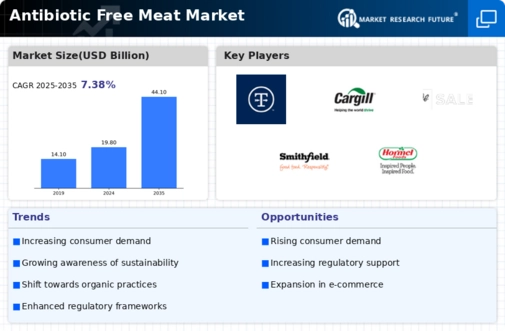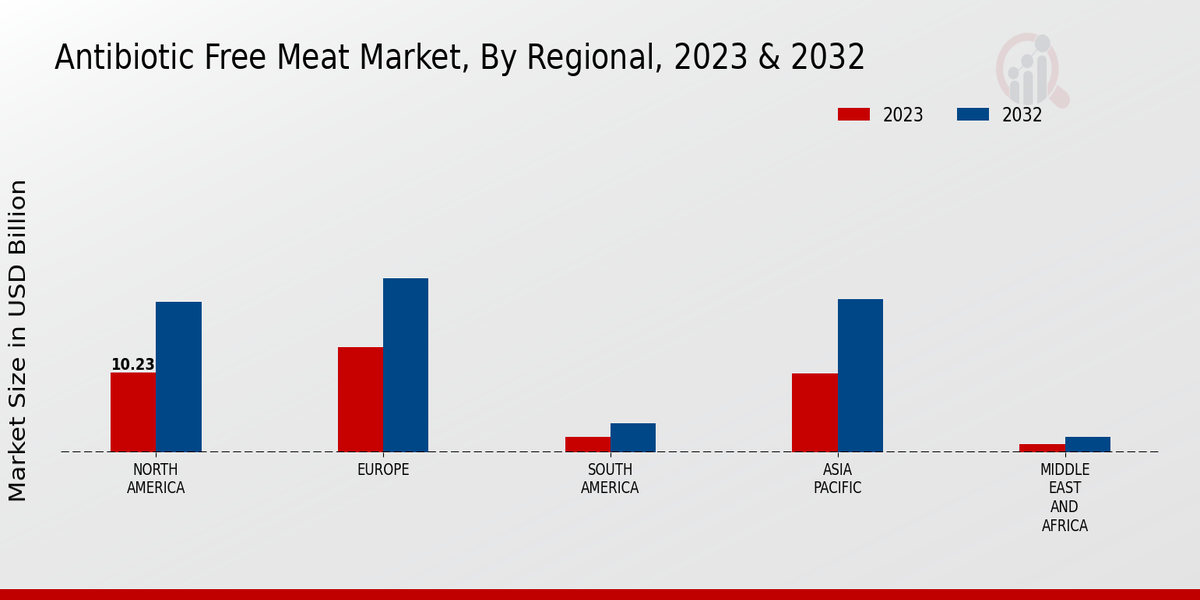Regulatory Support
Government regulations play a pivotal role in shaping the Global Antibiotic Free Meat Market Industry. Many countries are implementing stricter guidelines on antibiotic use in livestock, which encourages producers to adopt antibiotic-free practices. For instance, the European Union has already banned the use of antibiotics for growth promotion in animals. Such regulatory frameworks not only promote public health but also create a favorable environment for antibiotic-free meat production. As these regulations become more widespread, the market is likely to expand, with projections indicating a growth to 44.1 USD Billion by 2035, driven by compliance and consumer demand.
Health Consciousness
The Global Antibiotic Free Meat Market Industry is significantly influenced by the increasing health consciousness among consumers. With rising concerns about antibiotic resistance and its implications for public health, consumers are actively seeking meat products that are free from antibiotics. This trend is further supported by educational campaigns from health organizations that emphasize the risks associated with antibiotic use in livestock. As a result, the market is expected to witness substantial growth, with projections indicating a market size of 19.8 USD Billion in 2024. This health-driven demand is likely to shape the future of meat consumption globally.
Sustainability Trends
Sustainability is increasingly influencing consumer choices within the Global Antibiotic Free Meat Market Industry. As environmental concerns rise, consumers are gravitating towards meat products that are produced without antibiotics, which are often associated with more sustainable farming practices. This shift is evident in the growing number of farms adopting antibiotic-free methods, which align with broader sustainability goals. The market's growth trajectory, with a projected CAGR of 7.54% from 2025 to 2035, suggests that sustainability will continue to be a key driver, as consumers seek to support practices that are environmentally responsible.
Market Growth Projections
The Global Antibiotic Free Meat Market Industry is poised for robust growth, with projections indicating a market size of 19.8 USD Billion in 2024 and an anticipated increase to 44.1 USD Billion by 2035. This growth trajectory suggests a compound annual growth rate (CAGR) of 7.54% from 2025 to 2035. Such figures reflect the increasing consumer demand for antibiotic-free meat products, driven by health concerns, regulatory changes, and sustainability trends. The market's expansion is indicative of a broader shift in consumer preferences towards healthier and more ethically produced food options.
Rising Consumer Awareness
The Global Antibiotic Free Meat Market Industry is experiencing heightened consumer awareness regarding health and wellness. As individuals increasingly seek to avoid antibiotic residues in their food, the demand for antibiotic-free meat products has surged. This trend is supported by various health organizations advocating for reduced antibiotic use in livestock. In 2024, the market is projected to reach 19.8 USD Billion, reflecting a growing preference for meat that is perceived as healthier and safer. Consumers are becoming more discerning, often opting for products that are labeled as antibiotic-free, thus driving the market forward.
Innovative Marketing Strategies
Innovative marketing strategies are transforming the Global Antibiotic Free Meat Market Industry. Companies are increasingly leveraging digital platforms to educate consumers about the benefits of antibiotic-free meat, thereby enhancing brand visibility and consumer engagement. For example, social media campaigns that highlight the health benefits and ethical considerations of antibiotic-free products are resonating with a broader audience. This approach not only informs consumers but also fosters brand loyalty, which is crucial in a competitive market. As these strategies gain traction, they are likely to contribute to the market's growth, supporting the anticipated increase to 44.1 USD Billion by 2035.







